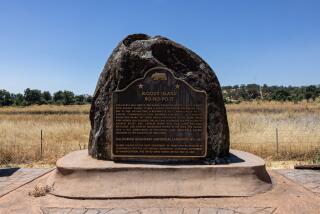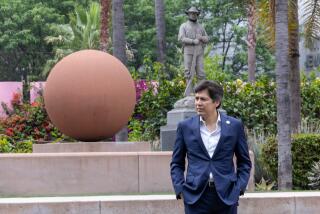Naming a site for a living person can be risky
When Richard Nixon died in 1994, The Times observed that he had “resuscitated his reputation and emerged as an elder statesman,” but “he never got his freeway back.”
The reference was to California 90, between the 405 Freeway and Marina del Rey, which state lawmakers had named in his honor in 1971.
In 1976, with Nixon’s image tarnished by Watergate, lawmakers quietly responded to the request of local Chamber of Commerce officials and took his name off the 2.5-mile roadway. The Nixon Freeway became the Marina Freeway.
The episode illustrates how naming a geographical place in honor of a living person can be risky.
In 1989, Gardner Street Elementary School in Hollywood unveiled Michael Jackson Auditorium.
But the school covered up the sign in 2003 after Jackson’s arrest on suspicion of child molestation.
Following his death last year, however, his fans called for his name to be restored, and the Los Angeles Unified School District agreed to do so in recognition of “his musical legacy and contribution to modern culture.”
Officials also pointed out that Jackson, who briefly attended Gardner Street, had been acquitted of the charges.
Local high schools have also had their naming controversies, two involving U.S. presidents.
In 1929, Warren G. Harding University High School on L.A.’s Westside was shortened to plain old University High School. This followed publicity over the Harding administration’s part in the Teapot Dome oil scandal.
A few years later, the L.A. school district proposed to name a new high school in Tujunga after Calvin Coolidge.
But local residents, led by Rep. (and poet) John McGroarty, successfully pushed for an alternative, Verdugo Hills High, to reflect the nearby “green Verdugo hills,” according to the school’s website.
It didn’t lessen McGroarty’s zeal that he was a Democrat and Coolidge a Republican.
Sometimes a once-prominent person’s moniker is taken off a building after he has committed the sin (in L.A., at least) of falling into obscurity.
Los Angeles’ Central Library, formerly named for USC President Rufus B. von KleinSmid (1875-1964), became the Richard J. Riordan Central Library in 2001 at the urging of influential friends of the mayor, who cited his efforts to promote reading and library improvements.
“Employees grumbled under their breath,” Times columnist Steve Lopez wrote. “Unfortunately, poor old Rufus couldn’t put up much of a fight. He’s dead.”
Lest no one forget who replaced Von KleinSmid, there is now a “Richard J. Riordan Central Library” directional sign on the 110 Freeway.
Almost as sad as seeing one’s name removed from a place of honor is having it spelled so badly that no one will recognize it.
Such was the case in 1960 when “Maurice Diller” was given a plaque on Hollywood’s Walk of Fame.
Almost three decades later, Times columnist Jack Smith pointed out that the honoree was supposed to be Mauritz Stiller (1883-1928), the Swedish film director who discovered Greta Garbo.
The Swedish Embassy asked for a new plaque and the Hollywood Chamber of Commerce complied, thereby ending joking speculation that the original was meant for some other Hollywood type, perhaps Barry Diller or Phyllis Diller’s husband or Jerry Stiller.
The late Assemblyman Vincent Thomas of San Pedro hasn’t officially had his name removed from the 47-year-old bridge dedicated in his honor, but a lot of folks think the name is the St. Vincent Thomas Bridge. It was even called that in the 1995 shoot-’em-up movie “Heat.”
“I can’t figure out what [the misconception over the name] is about,” Long Beach Press-Telegram columnist Tim Grobaty said. “I don’t recall, after my centuries of Catholic schooling, any St. Vincent Thomas — St. Vincent, St. Thomas, St. Vincent De Paul, Edna St. Vincent Millay, yes....”
But no St. Vincent Thomas.
In any event, the assemblyman will go down in history as one of the few politicians to be mistaken for a saint, even a nonexistent one.
No doubt many people view the name game as much ado about nothing except egos.
Consider the case of Hoover Dam, as Congress officially designated it in 1947.
For years before that a debate had raged over whether it should be named after Herbert Hoover, the former Republican president, or called Boulder Dam (as the Democrats preferred).
In “Colossus,” his history of Hoover Dam, author (and Times columnist) Michael Hiltzik quotes one newspaper letter writer who suggested this compromise:
“Hoogivza Dam.”
The letter writer added, “Now let’s hear no more about it.”
More to Read
Sign up for Essential California
The most important California stories and recommendations in your inbox every morning.
You may occasionally receive promotional content from the Los Angeles Times.










